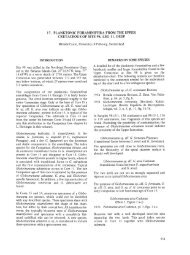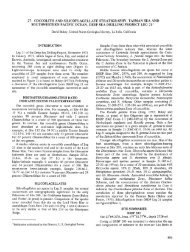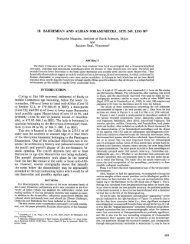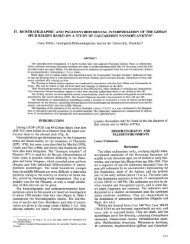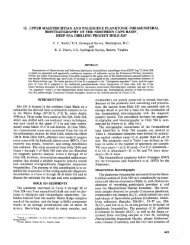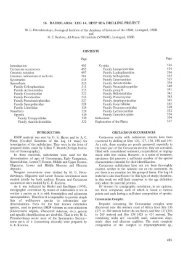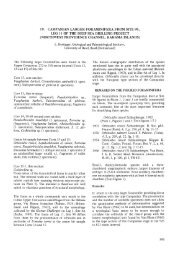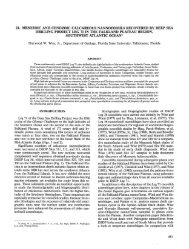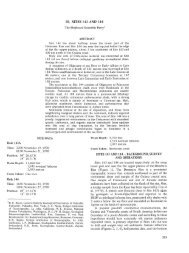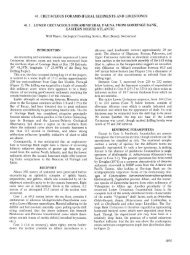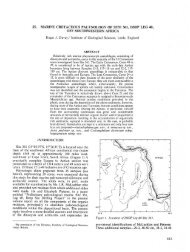1 - Deep Sea Drilling Project
1 - Deep Sea Drilling Project
1 - Deep Sea Drilling Project
Create successful ePaper yourself
Turn your PDF publications into a flip-book with our unique Google optimized e-Paper software.
SILICOFLAGELLATE AND DIATOM STRATIGRAPHY<br />
TABLE 1<br />
Approximate Temporal Relation of Tentative Late Cenozoic Phytoplankton Zones in the Eastern Pacific Ocean at<br />
Coring Sites DSDP 157, DSDP 158, and the Experimental Mohole (EM)<br />
Series or<br />
Sub series<br />
Holocene<br />
and<br />
Pleistocene<br />
Pliocene<br />
Upper<br />
Miocene<br />
Middle<br />
Miocene<br />
Age<br />
(my)<br />
_ 1<br />
_ 2<br />
3<br />
4<br />
5<br />
_ 6<br />
__ 7<br />
_ 8<br />
9<br />
10<br />
11<br />
12<br />
1 *<br />
14<br />
is<br />
Coccolith<br />
Zone<br />
E. huxleyi<br />
G. oceanica<br />
C. doronocoides<br />
D. brouweri<br />
R. pseudoumbilica<br />
C. tricorniculatus<br />
D. quinqueramus<br />
D. neohamatus<br />
D. hamatus<br />
C. coalitus<br />
D. exilis<br />
S. hetβromorphus<br />
for some samples did not reach 100. To confirm the<br />
distributions of stratigraphic marker species—Dictyocha<br />
epiodon, Mesocena elliptica, and Octactis pulchra—counts<br />
of 300 or more were made for the upper twelve cores of<br />
Hole DSDP 157. Percentages for species in the silicoflagellate<br />
assemblages and the total counts are presented in<br />
Tables 2 to 5.<br />
Paleoenvironmental Analysis<br />
Silicoflagellates, like diatoms, are most productive in<br />
areas of oceanic upwelling, where the near-surface water<br />
has high levels of silica and nutrients (Lipps, 1970). The<br />
taxonomic composition of living silicoflagellate populations<br />
is controlled to some extent by temperature, which<br />
is reflected in a reversal in dominance between the genera<br />
Silicoflagellate<br />
Zone<br />
D. epiodon<br />
M. elliptica<br />
D. boliviensis<br />
C. major<br />
D. crux<br />
D. longispinus<br />
C. triacantha<br />
D. octacanthus<br />
9<br />
Diatom<br />
Zone<br />
R. tesselata<br />
Chaetoceros sp.<br />
H. cuneiformis<br />
C. plicatus<br />
« _ _ _ _ _ _ ^ «_ mm ~•- — — ^ —<br />
C. coscinodiscus<br />
Dictyocha and Distephanus in warm and cold water respectively<br />
(Gemeinhardt, 1934). A curve that gives an<br />
approximate relation between actual temperature and the<br />
ratio of Dictyocha to Distephanus has been prepared by<br />
Mandra (1969). This curve has been used as the basis for<br />
paleotemperatures determined for DSDP 157 and DSDP<br />
158 in the Panama Basin. For paleotemperature calculations,<br />
the Distephanus-like genus Octactis was counted as<br />
Distephanus. To allow for very high Dictyocha/Distephanus<br />
ratios (warm water) in our assemblages, it was<br />
necessary to extrapolate Mandra's curve with 3 by 3 log<br />
paper. The curve asymptotically approaches 3 TC, which<br />
is in good agreement with the highest annual open-ocean<br />
water temperature at low latitude. Temperatures determined<br />
for Miocene to Pleistocene cores of the Panama<br />
Basin range from 23 to 30°C, with fluctuations related to<br />
9<br />
817



